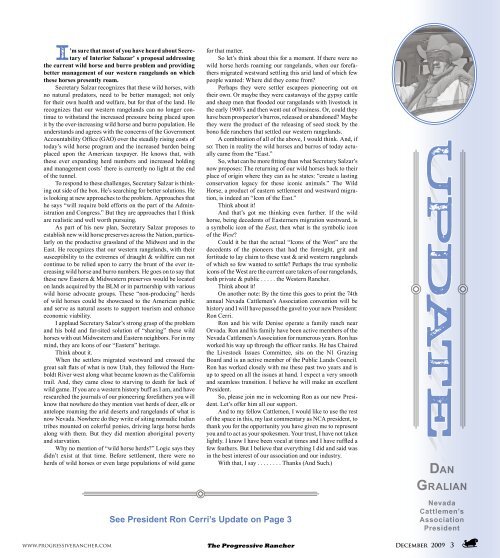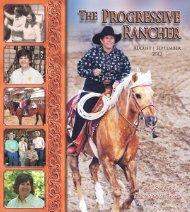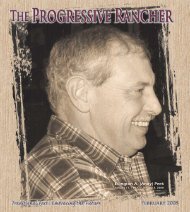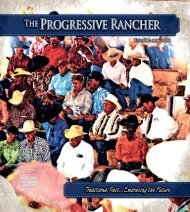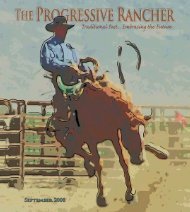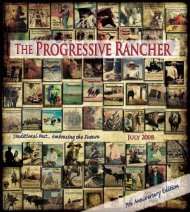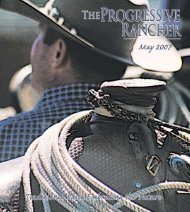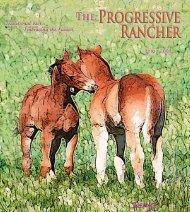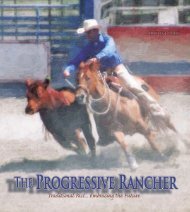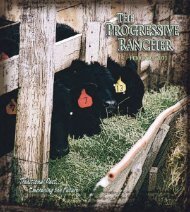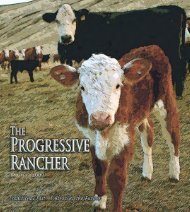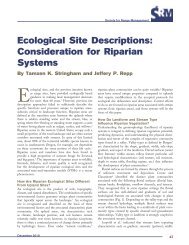The Progressive Rancher Magazine
The Progressive Rancher Magazine
The Progressive Rancher Magazine
You also want an ePaper? Increase the reach of your titles
YUMPU automatically turns print PDFs into web optimized ePapers that Google loves.
I<br />
’m sure that most of you have heard about Secretary<br />
of Interior Salazar’ s proposal addressing<br />
the current wild horse and burro problem and providing<br />
better management of our western rangelands on which<br />
these horses presently roam.<br />
Secretary Salzar recognizes that these wild horses, with<br />
no natural predators, need to be better managed; not only<br />
for their own health and welfare, but for that of the land. He<br />
recognizes that our western rangelands can no longer continue<br />
to withstand the increased pressure being placed upon<br />
it by the ever-increasing wild horse and burro population. He<br />
understands and agrees with the concerns of the Government<br />
Accountability Office (GAO) over the steadily rising costs of<br />
today’s wild horse program and the increased burden being<br />
placed upon the American taxpayer. He knows that, with<br />
these ever expanding herd numbers and increased holding<br />
and management costs’ there is currently no light at the end<br />
of the tunnel.<br />
To respond to these challenges, Secretary Salzar is thinking<br />
out side of the box. He’s searching for better solutions. He<br />
is looking at new approaches to the problem. Approaches that<br />
he says “will require bold efforts on the part of the Administration<br />
and Congress.” But they are approaches that I think<br />
are realistic and well worth pursuing.<br />
As part of his new plan, Secretary Salzar proposes to<br />
establish new wild horse preserves across the Nation, particularly<br />
on the productive grassland of the Midwest and in the<br />
East. He recognizes that our western rangelands, with their<br />
susceptibility to the extremes of draught & wildfire can not<br />
continue to be relied upon to carry the brunt of the ever increasing<br />
wild horse and burro numbers. He goes on to say that<br />
these new Eastern & Midwestern preserves would be located<br />
on lands acquired by the BLM or in partnership with various<br />
wild horse advocate groups. <strong>The</strong>se “non-producing” herds<br />
of wild horses could be showcased to the American public<br />
and serve as natural assets to support tourism and enhance<br />
economic viability.<br />
I applaud Secretary Salzar’s strong grasp of the problem<br />
and his bold and far-sited solution of “sharing” these wild<br />
horses with out Midwestern and Eastern neighbors. For in my<br />
mind, they are Icons of our “Eastern” heritage.<br />
Think about it.<br />
When the settlers migrated westward and crossed the<br />
great salt flats of what is now Utah, they followed the Humboldt<br />
River west along what became known as the California<br />
trail. And, they came close to starving to death for lack of<br />
wild game. If you are a western history buff as I am, and have<br />
researched the journals of our pioneering forefathers you will<br />
know that nowhere do they mention vast herds of deer, elk or<br />
antelope roaming the arid deserts and rangelands of what is<br />
now Nevada. Nowhere do they write of siting nomadic Indian<br />
tribes mounted on colorful ponies, driving large horse herds<br />
along with them. But they did mention aboriginal poverty<br />
and starvation.<br />
Why no mention of “wild horse herds?” Logic says they<br />
didn’t exist at that time. Before settlement, there were no<br />
herds of wild horses or even large populations of wild game<br />
for that matter.<br />
So let’s think about this for a moment. If there were no<br />
wild horse herds roaming our rangelands, when our forefathers<br />
migrated westward settling this arid land of which few<br />
people wanted: Where did they come from?<br />
Perhaps they were settler escapees pioneering out on<br />
their own. Or maybe they were castaways of the gypsy cattle<br />
and sheep men that flooded our rangelands with livestock in<br />
the early 1900’s and then went out of business. Or, could they<br />
have been prospector’s burros, released or abandoned? Maybe<br />
they were the product of the releasing of seed stock by the<br />
bono fide ranchers that settled our western rangelands.<br />
A combination of all of the above, I would think. And, if<br />
so: <strong>The</strong>n in reality the wild horses and burros of today actually<br />
came from the “East.”<br />
So, what can be more fitting than what Secretary Salzar’s<br />
now proposes: <strong>The</strong> returning of our wild horses back to their<br />
place of origin where they can as he states: “create a lasting<br />
conservation legacy for these iconic animals.” <strong>The</strong> Wild<br />
Horse, a product of eastern settlement and westward migration,<br />
is indeed an “Icon of the East.”<br />
Think about it!<br />
And that’s got me thinking even further. If the wild<br />
horse, being decedents of Easterners migration westward, is<br />
a symbolic icon of the East, then what is the symbolic icon<br />
of the West?<br />
Could it be that the actual “Icons of the West” are the<br />
decedents of the pioneers that had the foresight, grit and<br />
fortitude to lay claim to these vast & arid western rangelands<br />
of which so few wanted to settle? Perhaps the true symbolic<br />
icons of the West are the current care takers of our rangelands,<br />
both private & public . . . . . the Western <strong>Rancher</strong>.<br />
Think about it!<br />
On another note: By the time this goes to print the 74th<br />
annual Nevada Cattlemen’s Association convention will be<br />
history and I will have passed the gavel to your new President:<br />
Ron Cerri.<br />
Ron and his wife Denise operate a family ranch near<br />
Orvada. Ron and his family have been active members of the<br />
Nevada Cattlemen’s Association for numerous years. Ron has<br />
worked his way up through the officer ranks. He has Chaired<br />
the Livestock Issues Committee, sits on the N1 Grazing<br />
Board and is an active member of the Public Lands Council.<br />
Ron has worked closely with me these past two years and is<br />
up to speed on all the issues at hand. I expect a very smooth<br />
and seamless transition. I believe he will make an excellent<br />
President.<br />
So, please join me in welcoming Ron as our new President.<br />
Let’s offer him all our support.<br />
And to my fellow Cattlemen, I would like to use the rest<br />
of the space in this, my last commentary as NCA president, to<br />
thank you for the opportunity you have given me to represent<br />
you and to act as your spokesmen. Your trust, I have not taken<br />
lightly. I know I have been vocal at times and I have ruffled a<br />
few feathers. But I believe that everything I did and said was<br />
in the best interest of our association and our industry.<br />
With that, I say . . . . . . . . Thanks (And Such.)<br />
UPDATE<br />
Da n<br />
Gr a l i a n<br />
See President Ron Cerri’s Update on Page 3<br />
Nevada<br />
Cattlemen’s<br />
Association<br />
President<br />
www.progressiverancher.com<br />
<strong>The</strong> <strong>Progressive</strong> <strong>Rancher</strong> December 2009 3


